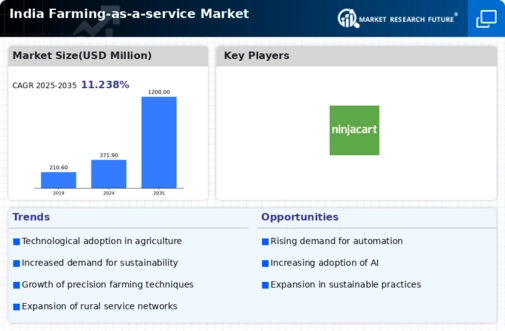Rising Demand for Food Security
The increasing population in India has led to a heightened demand for food security, which significantly impacts the farming as-a-service market. As the population is projected to reach 1.5 billion by 2030, the need for efficient agricultural practices becomes paramount. This demand drives farmers to seek innovative solutions that enhance productivity and sustainability. The farming as-a-service market provides access to advanced technologies and resources, enabling farmers to optimize their yields. Moreover, government initiatives aimed at improving food security further bolster this market, as they encourage the adoption of modern farming techniques. The integration of data analytics and precision agriculture within the farming as-a-service market is likely to play a crucial role in meeting these food security challenges, ensuring that agricultural output keeps pace with population growth.
Shift Towards Sustainable Practices
The shift towards sustainable agricultural practices is increasingly influencing the farming as-a-service market in India. With growing awareness of environmental issues, farmers are seeking solutions that minimize their ecological footprint. The farming as-a-service market offers sustainable options such as organic farming, integrated pest management, and water conservation techniques. This trend is supported by consumer demand for sustainably produced food, which is expected to grow by 30% in the coming years. Additionally, government regulations promoting sustainable practices further encourage farmers to adopt these methods. As sustainability becomes a priority, the farming as-a-service market is likely to expand, providing farmers with the tools and resources necessary to implement eco-friendly practices while maintaining profitability.
Access to Financial Services and Credit
Access to financial services is a crucial driver for the farming as-a-service market in India. Many farmers face challenges in securing credit for investments in modern agricultural practices. However, the emergence of fintech solutions tailored for the agricultural sector is changing this landscape. These platforms provide farmers with easier access to loans and financial products, enabling them to invest in farming as-a-service solutions. The market for agricultural fintech is expected to grow significantly, with projections indicating a potential increase of 40% in the next few years. This financial accessibility empowers farmers to adopt innovative technologies and practices, ultimately enhancing their productivity and income. As financial services continue to evolve, they are likely to play a vital role in the expansion of the farming as-a-service market.
Government Support and Policy Initiatives
Government support in India is a critical driver for the farming as-a-service market. Various policy initiatives, such as subsidies for technology adoption and financial assistance for farmers, are designed to promote modern agricultural practices. The Pradhan Mantri Kisan Samman Nidhi scheme, which provides direct income support to farmers, encourages them to invest in farming as-a-service solutions. Additionally, the government's focus on digitizing agriculture through initiatives like Digital India enhances the accessibility of farming services. This support not only aids in reducing the financial burden on farmers but also fosters a conducive environment for the growth of the farming as-a-service market. As policies evolve to address the challenges faced by the agricultural sector, the market is expected to expand, driven by increased participation from both small and large-scale farmers.
Technological Advancements in Agriculture
Technological advancements are revolutionizing the agricultural landscape in India, thereby driving the farming as-a-service market. Innovations such as drones, IoT devices, and AI-driven analytics are becoming increasingly accessible to farmers. These technologies facilitate precision farming, enabling farmers to monitor crop health, optimize resource usage, and enhance productivity. The market for agricultural technology in India is projected to grow at a CAGR of 25% over the next five years, indicating a robust demand for farming as-a-service solutions. Furthermore, the integration of mobile applications allows farmers to access real-time data and expert advice, making informed decisions that improve their yields. As these technologies continue to evolve, they are likely to play a pivotal role in shaping the future of the farming as-a-service market.

















Leave a Comment